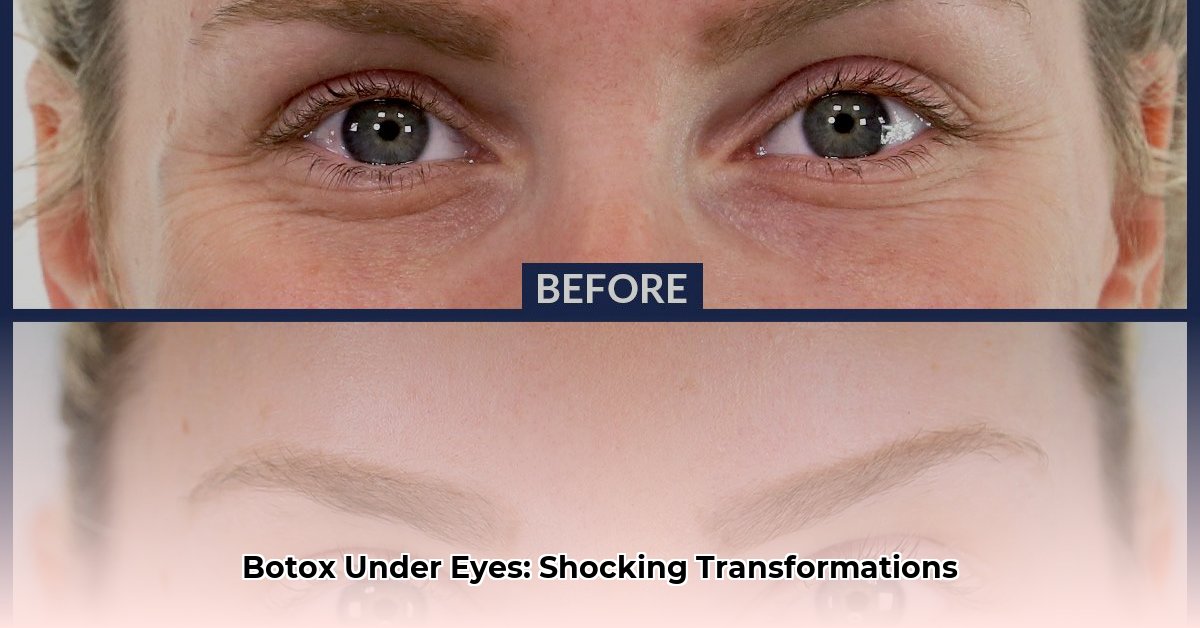Rejuvenating Your Eyes with Botox: A Comprehensive Guide
Worried about fine lines and wrinkles diminishing the youthful vibrancy of your eyes? You’re not alone. Many people explore Botox as a solution for a refreshed, more awake appearance. This guide provides a comprehensive overview of Botox for the under-eye area, showcasing real results, explaining the procedure, and addressing common concerns.
Understanding Under-Eye Botox
What is Under-Eye Botox?
Under-eye Botox, sometimes called “jelly roll Botox,” involves injecting tiny amounts of a purified protein (botulinum toxin) into specific muscles beneath the skin’s surface. This relaxes the muscles that contribute to wrinkles, softening the appearance of crow’s feet and other fine lines around the eyes. While Botox can subtly lift the lower eyelid, potentially reducing shadows, it’s essential to note that it’s not a solution for dark circles or significant under-eye bags resulting from volume loss.
How Does it Work?
Facial expressions, like smiling and squinting, cause tiny muscles around the eyes to contract. Over time, this repeated movement creates wrinkles. Botox temporarily relaxes these muscles, easing the tension and smoothing the overlying skin. It’s like gently releasing the tension on a tightly wound spring.
The Under-Eye Botox Procedure: A Step-by-Step Guide
- Consultation: A qualified practitioner (dermatologist, plastic surgeon, etc.) will discuss your concerns, assess your skin, and explain the procedure, setting realistic expectations about potential outcomes.
- Preparation: The treatment area is cleaned, and the injection sites are marked. A numbing cream may be applied to minimize discomfort.
- Injection: Using a very fine needle, precise amounts of Botox are injected into the targeted muscles. The injections are generally quick and feel like a mild pinch.
- Post-Treatment: There is minimal downtime. You can likely resume normal activities immediately. Some temporary redness or swelling at the injection sites is possible.
Visualizing the Transformation: Botox Under Eyes Before & After Photos
(Insert a slider or gallery of diverse before & after photos here. Showcase various age ranges, ethnicities, and wrinkle severities. Include captions with specifics if available.) These photos provide a powerful illustration of how Botox can rejuvenate the under-eye area, although individual results will vary depending on skin type, wrinkle depth, and other factors.
Exploring the Benefits and Considerations
Advantages of Under-Eye Botox
- Reduces crow’s feet and fine lines: Botox significantly smooths dynamic wrinkles caused by muscle movement.
- Minimally invasive: No surgery or significant downtime is required.
- Refreshed Appearance: Creates a more youthful and awake look around the eyes.
Potential Drawbacks and Considerations
- Temporary results: Botox effects typically last 3-6 months, requiring repeat treatments for maintenance.
- Not a solution for all under-eye concerns: It won’t address volume loss, significant skin laxity, or dark circles.
- Potential side effects: While generally rare and temporary, potential side effects include bruising, swelling, or, in very rare cases, temporary eyelid drooping.
The Importance of Choosing a Qualified Injector
Selecting a board-certified dermatologist, plastic surgeon, or other licensed medical professional with expertise in facial aesthetics is paramount. A skilled injector understands facial anatomy, minimizes risks, and tailors the treatment for optimal results. Don’t hesitate to ask for credentials, experience, and before & after photos.
Cost of Treatment
The cost of under-eye Botox varies based on factors like location, the injector’s experience, and units of Botox used. Expect a range of $300 to $600 per treatment session. Consultations typically include personalized cost estimates.
Exploring Alternative Treatments
Botox isn’t the only solution for under-eye concerns. Other effective options include:
- Dermal Fillers: Restore volume and reduce the appearance of under-eye hollows and dark circles.
- Laser treatments: Improve skin texture, tone, and stimulate collagen production.
- Chemical Peels: Exfoliate the skin and improve its appearance.
- Topical Retinoids: Reduce fine lines and wrinkles over time.
Often, a combination of treatments provides the most comprehensive rejuvenation.
Maintaining Your Results
Regular Botox treatments every 3-6 months, combined with a consistent skincare regimen (sun protection, moisturizing, etc.), can help maintain your refreshed look. Your practitioner can advise on the best maintenance plan for you.
Frequently Asked Questions (FAQs)
| Question | Answer |
|---|---|
| How long do results last? | Typically 3-4 months, but individual results can vary. |
| Is it painful? | Most people experience minimal discomfort, often described as a slight pinch. |
| When will I see results? | Gradual improvement within a few days, with full results within two weeks. |
| Are there any side effects? | Common temporary side effects may include mild bruising or swelling at the injection site. |
| How much does it cost? | Varies, but generally ranges from $300 to $600 per treatment. |
| How do I find a qualified injector? | Look for board-certified dermatologists or plastic surgeons with experience in facial aesthetics. |
Understanding the Causes of Under-Eye Wrinkles
Under-eye wrinkles develop due to a combination of factors:
- Natural aging: Decreased collagen and elastin production leads to thinner, less elastic skin.
- Sun exposure: UV rays damage collagen and elastin, accelerating aging and wrinkle formation.
- Repeated muscle contractions: Facial expressions like smiling and squinting create dynamic wrinkles over time.
Beyond Botox: Other Approaches to Under-Eye Rejuvenation
If Botox isn’t the ideal solution for your specific needs, other approaches can complement or offer alternative solutions:
- Microneedling: This procedure uses tiny needles to create micro-injuries in the skin, stimulating collagen and elastin production.
- Radiofrequency treatments: These treatments use radiofrequency energy to heat the skin, promoting collagen production and tightening.
- Topical creams and serums: While not as dramatic as injectables or other procedures, certain topical products containing retinol, peptides, or antioxidants can improve skin texture and reduce the appearance of fine lines over time.
The Science Behind Botox: A Deeper Dive
Botox, or onabotulinumtoxinA, is a neurotoxin derived from Clostridium botulinum. However, it’s important to understand that the purified form used in cosmetic treatments is extremely safe when administered by a qualified professional. It blocks nerve signals that cause muscle contractions, temporarily reducing muscle activity and smoothing out wrinkles.
Ongoing Research and Future Directions
Research in cosmetic treatments like Botox is continuously evolving. Studies are exploring potential long-term effects of repeated use and investigating new techniques for enhanced precision and longevity. For example, some researchers are exploring the possibility of combining Botox with other treatments, such as dermal fillers or laser therapy, to achieve more comprehensive and long-lasting results.
This information aims to provide a thorough overview of Botox for the under-eye area. However, it does not replace professional medical advice. A consultation with a qualified practitioner is essential for personalized treatment recommendations.
- Bento Box Shopping Tips for Smart and Stylish Lunch Prep - December 14, 2025
- Bento Box Trays Streamline Restaurant Meal Presentation and Transport - December 13, 2025
- Plastic Bento Boxes Face Scrutiny Over Sustainability Impacts - December 11, 2025










